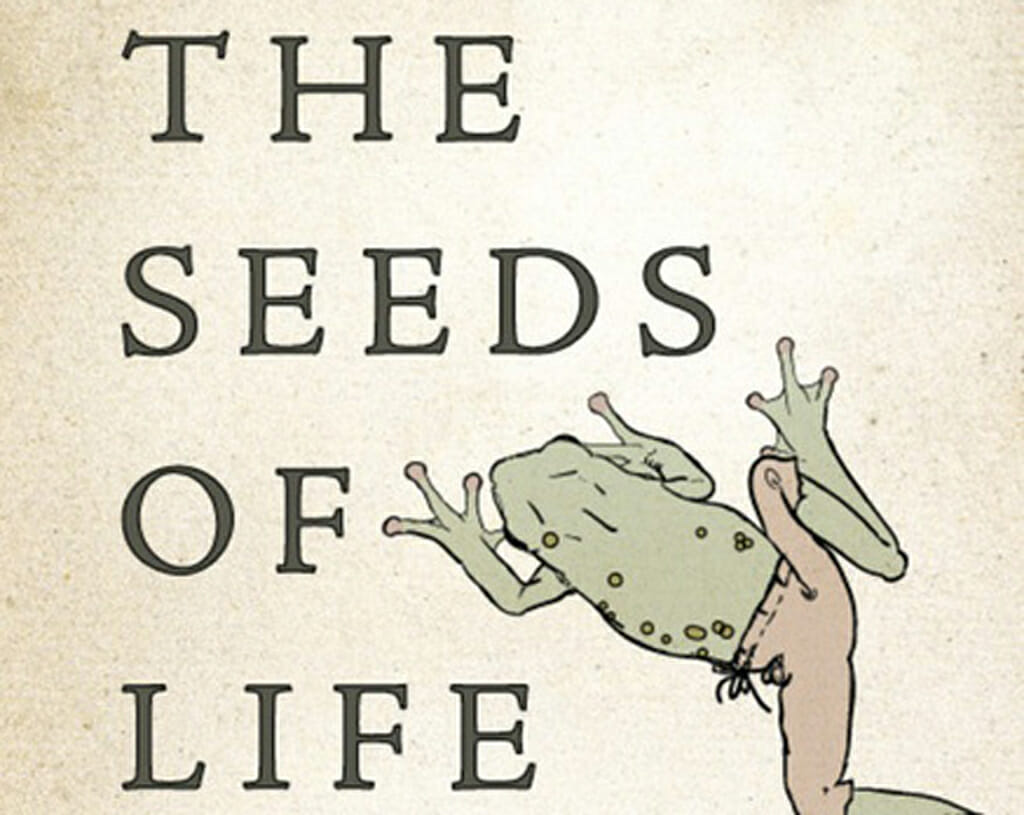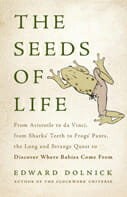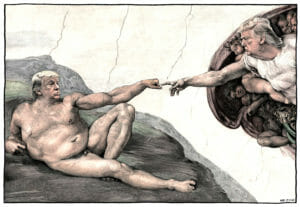We’ve Come a Long Way, Babies
Author Edward Dolnick tracks the blind spots that prevented the greatest minds from figuring out how two beings make one. Basic Books
Basic Books

Purchase in the Truthdig Bazaar
“The Seeds of Life: From Aristotle to da Vinci, from Sharks’ Teeth to Frogs’ Pants, the Long and Strange Quest to Discover Where Babies Come From”
A book by Edward Dolnick
We’ve all heard the joke: A drunk man is bent down searching for something on the street. A policeman passes by and asks what he’s looking for. “My key,” the man answers. The policeman joins the search, but after a few minutes asks the man if he is certain he lost it nearby. “No, I lost it two blocks from here.” The policeman asks why then, is he looking for it here? The drunk man replies: “This is where the light is!”
This joke becomes scientific history stretched over centuries in Edward Dolnick’s witty, engaging book with an appropriately meandering subtitle, “The Seeds of Life: From Aristotle to da Vinci, from Sharks’ Teeth to Frogs’ Pants, the Long and Strange Quest to Discover Where Babies Come From.” Until relatively recently, scientists have been stumbling in the dark when it comes to animal procreation, groping for answers in the few illuminated areas available to them. Dolnick tracks the many scientific, mechanical, but more often philosophical blind spots that prevented the greatest minds who ever lived from figuring out how two beings make one. The result is an amusing detective story filled with head scratching doozies and dead ends that is as much a history of science as it is a history of the science of reproduction. Dolnick manages to make the story fun (a crash course in early human cadaver experiments and the bit about the little frog pants mentioned in the subtitle are particular highlights) and I have to admit, there’s a certain joy to be had in reading how the “bold men of science raced off to take on the mystery of life and promptly face-planted.”
Click here to read long excepts from “The Seeds of Life” at Google Books.
It goes without saying that humans have known the basic premise of how babies are made since the very beginning: only when a man had sex with a woman of childbearing age did she get pregnant. But not always. And for a long time, that’s as far as we got. Why sex didn’t always result in a child was the first of many questions that would be asked and remain unanswered for centuries. But it wasn’t for lack of trying. Dolnick shares a kaleidoscope of misguided theories and practices from the ancient world: “At some point or other, nearly everything was pinpointed as the vital factor behind conception: sunlight, moonlight, rainbows, thunder, lightning, rain, a cobra’s hiss, the aroma of a cooked dragon’s heart. . . . In China, swallowing a stone or a pearl or drinking dew brought babies; in Ireland, drinking saint’s tears; in India, accidentally ingesting crane’s dung.” Conversely, recipes for contraceptives included “feces of crocodile, smashed up with fermented dough. . . . Arabic medical texts often recommended contraceptive suppositories made from elephant dung.” Before conception was even a possibility, making sure the coupling even happened may require some intervention as well. According to one Egyptian papyrus, an aphrodisiac prescribed: “Take dandruff from the scalp of a dead man, who was murdered . . . add the blood of a tick from a black dog, a drop of blood from the ring finger of your left hand, and your semen.”
Some practices were based on theories, as misguided as they were. Even in some cultures today, there is the belief that a baby is made little by little. Dolnick quotes a scientist who shares that many of his friends from New Guinea “feel obliged to have regular sex right up to the end of the pregnancy . . . because they believe that repeated infusions of semen furnish the material to build the fetus’s body.” In Venezuela, the Bari people believe “it is best if several different men make a contribution [and] a good mother will make a point of having sex with several different men, especially when she is pregnant so that her child will enjoy the qualities not merely of the best hunter, but also of the best storyteller, the strongest warrior, and the most considerate lover.” For the Bari, it really does take a village.
As captivating as it is to explore the wildly varied attempts at explaining sex and conception, Dolnick tightens his focus soon after on Europe, where “the path of misinformation is easiest to trace.” From here, “The Seeds of Life” turns into a detective novel. Even though we know how it ends, and we’re rooting for our protagonists (the scientists) the whole time, Dolnick’s path to the truth is still engrossing.
For much of history, progress toward the truth about procreation came in fits and starts. A discovery only led to more unanswered questions. Perhaps the first genuine advance in solving the puzzle starts with the Renaissance Man himself, Leonardo da Vinci. After watching an execution, he noted that while the man was dead, his member was very much alive and that “many die thus, especially those hanged.” Postmortem dissections of their . . . parts revealed that all of them had “great density and hardness, and being quite filled up by a large quantity of blood.” Up until that point, conventional wisdom assumed that an erect penis was inflated with air. Da Vinci argued however, that if “a large quantity of flesh has grown through wind, causing the enlargement and hardness as in a ball with which one plays, such wind gives neither weight nor density but makes flesh light and rarified [and] there would have to be a great wind to enlarge and elongate the penis, and make it as dense as wood.” He figures out that, anatomically at least, it is blood that causes erections. On the one hand, Da Vinci makes this logical leap when it comes to the male anatomy, but on the other, he is also responsible for drawing an image of a woman who “lacks ovaries . . . [but] has a mysterious tube running from her uterus to nipple . . . a theory dreamed up by the Greeks to explain why pregnant women and new others did not menstruate.” While da Vinci was simply visualizing the common thinking of his day, his discovery only spurs more questions.
Although da Vinci imagined machines far ahead of his time, he somehow failed to make the connection that the blood in the penis got there because it was circulated by the heart. It wasn’t until over a century later in 1628 that a scientist named William Harvey would make this discovery. Like the idea of a clockwork universe, science was often unlocked through analogy. It could very well be that da Vinci didn’t have the analogous technology around to make the connection, but by Harvey’s time, “firefighters had begun using powerful pumps that shot out jets of water.” The heart as a pump was all of a sudden crystal clear.
Harvey was a physician to King Charles I. After knocking out his “The heart is a pump”triumph, he turned his attention to the great mystery of the day: sex and reproduction. Unlike da Vinci, Harvey was a master anatomist and dissected anything he could get his hands on. The “king’s deer, which mated and conceived on the same predictable schedule year after year, seemed ideal research subjects.” He waited until the deer mated and opened up the does, hoping to find eggs, semen or embryos. He found none of them; semen would’ve been too small for the naked eye and deer would only have only one embryo that typically takes a full 10 days to appear. Harvey didn’t have the necessary tools and his timing was off. And perhaps most unfortunately for Harvey, deer eggs don’t have the familiar egg shape, but are instead “long, slender, strand-like and easy to miss even when you know what to look for.” Harvey actually did see the deer eggs, but had no idea what they were and had even less of an idea of where the semen from the bucks had gone. He concluded that females conceived “as by Contagion,” with semen acting as a kind of vapor, the way magnets exert force without actually making physical contact. But it was only a guess, and he admitted that there was “no sensible [i.e., detectable] thing to be found in the uterus, after coition . . . and yet there is a necessity that something should be there.” Dolnick notes however, that Harvey moves the needle forward for the next generation, throwing down the gauntlet that “the way to take on this mystery was to stop talking and start experimenting.”
By 1672, a scientist named de Graaf had the fortune of experimenting on rabbits instead, and deduced that the “egg emerged from the female’s ovary and combined somehow with semen from the male to form a new organism.” He didn’t know how this actually occurred, but his choice of subject was a fortunate one: “It so happens that in rabbits the act of mating stimulates the female to release eggs. Watching his rabbits, de Graaf witnessed a straightforward series of events: a female mated, follicles within her ovary changed, the follicles ruptured, embryos developed, and the number of embryos matched (usually) the number of ruptured follicles.” That process isn’t true with other mammals, and certainly not with humans, but de Graaf’s contribution was solid enough: females had eggs and when combined with semen, became embryos. He made a bold claim that was partly correct and partly a guess, but he moved the ball a little further down the field.
Still, semen remained an enigma and like Harvey, de Graaf talked of “‘seminal vapor’ and ‘irradiation’ and pictured semen somehow manipulating the process of conception like a magician waving his fingers.” That part of the mystery would not be solved by bold claims or luck; this time, technology would lend a hand, in the form of the microscope. In 1677, a Dutchman by the name of Antony van Leeuwenhoek had devised a superior microscope and, after making love to his wife one night, “leapt up ‘immediately after ejaculation before six beats of the pulse has intervened,’ and ran to his microscope with a sample of semen. There Leeuwenhoek saw ‘so great a number of living animalcules that sometimes more than a thousand were moving about in an amount of material the size of a grain of sand.” Semen wasn’t vapor and magic at a distance, as Harvey and de Graaf concluded by default. There were living things swimming in there, so it had to be part of the action. But before the reader can celebrate at the discovery, Dolnick deals a buzzkill: Leeuwenhoek “vehemently misunderstood his own discovery.” Similar to da Vinci, Leeuwenhoek did not have the language of cells as building blocks of life, and so dismissed the sperm cells as actual small animals within the fluid of the semen that had nothing to do with reproduction. Like a suspect making a narrow escape, the mystery would continue.
Dolnick explores other barriers that prevent these early scientists from making headway, but throughout “The Seeds of Life” one single roadblock prevented progress more than any other: good, old-fashioned lack of imagination, largely due to religion. Christianity was at that point an inescapable fact, and science and religion were considered as one. In the 17th and 18th centuries, “virtually all the major scientists in Europe were devout Christians [and] every declaration about the world was also a statement about God.” A scientific theory had a theological consequence and we are reminded that Galileo “brought the Inquisition down on his head for suggesting that the earth moved around the sun.” Dolnick lays out a strong case for how our ideas of God and creation helped construct a formidable box that early scientists could not, or would not, think outside of. It was firmly believed that God had “created the inanimate world in one go. That was certain. It followed, inevitably, that he had created the living world in one go. . . . Every person who would ever live, down to the end of time, had been created at the same time. . . . That was the only possibility that was in keeping with God’s nature.” This theology provided very little wiggle room when it came to the idea of life begetting new life without God’s intervention. If a man and woman can take it upon themselves to create new life, wouldn’t that make humans as powerful as God himself? And that’s the wrong kind of question to ask. No, the child must’ve been created by God in the beginning of time and had somehow been stowed away, dormant, for generations. Scientists searched for mini-humans folded inside the egg, or perhaps in those animalcules within semen, prefabricated and shrunk down to an unseeable speck and hidden, generations inside generations inside generations. This “Russian doll theory” kept scientists from actually seeing the truth of the evidence presented before them. It sounds ludicrous now, but this was mainstream science at the time, and scientists spun their wheels debating theories with names like encasement, preformation and preexistence. Similar to the drunk man in the joke, scientists had unfortunately created a perimeter around themselves, and were left searching for keys in the only place there was light.
Dolnick achieves a neat trick in “The Seeds of Life.” As he walks us through the maze of divergent ideas, roadblocks and red herrings, the scientific facts about procreation that we already know become all the more astounding and we realize “the truth is so far-fetched that it is a wonder that anyone believes it.” I’ve recently witnessed my wife grow and give birth to our second daughter. About a year ago, one of my cells found its way toward one of her cells. The two cells fused into one before then multiplying billions of times over into many different kinds of cells. As a result, there is a tiny human being in our living room now that has a liver in the right place, that breathes air into its lungs so that it can scream, and has a brain that can register joy and express it with a heart-melting, open mouthed smile. “The Seeds of Life” was a delightful, humbling reminder of why a new life can and should be called miraculous. As Dolnick so beautifully puts it, “familiarity drains the surprise from events that should make our jaws drop in disbelief. We think there is something magical about getting a rabbit out of a hat, the writer John Stewart Collis once observed. Not so. The real magic is getting a rabbit out of a rabbit.”
Your support matters…
Independent journalism is under threat and overshadowed by heavily funded mainstream media.
You can help level the playing field. Become a member.
Your tax-deductible contribution keeps us digging beneath the headlines to give you thought-provoking, investigative reporting and analysis that unearths what's really happening- without compromise.
Give today to support our courageous, independent journalists.





You need to be a supporter to comment.
There are currently no responses to this article.
Be the first to respond.